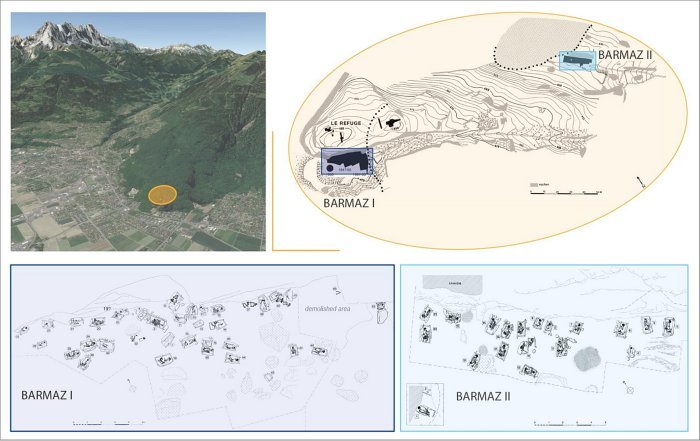Conny Waters – AncientPages.com – An isotopic analysis conducted on ancient human remains indicates that men and women possessed equivalent access to resources approximately 6,000 years ago.
In orange, the location of the site of Barmaz, looking south. It is located on the plain, at the foot of the Chablais massif, which rises to an altitude of 2500 m. The site is divided into two contemporary burial areas named Barmaz I (dark blue) and Barmaz II (light blue) (Honegger and Desideri 2003, modified). Credit: Journal of Archaeological Science: Reports (2024). DOI: 10.1016/j.jasrep.2024.104585
Using isotope geochemistry, a team from the University of Geneva (UNIGE) has uncovered new information about the Barmaz necropolis in Valais (Switzerland): 14% of the people buried 6,000 years ago at this site were not locals.
This finding challenges the prevailing notion of gender-based disparities in resource allocation during that era and suggests a more egalitarian societal structure existed among the population under investigation.
This Middle Neolithic agropastoral society, recognized as one of the earliest known in the western region of Switzerland, exhibited a relatively egalitarian structure, a study says. The examined bones reveal that all members of the community, including people from elsewhere, had access to the same food resources.
The Neolithic era began with animal husbandry and agricultural practices. In Switzerland, this epoch spanned between 5500 BC and persisted until approximately 2200 BC. The first agropastoral communities gradually moved from a predatory economy—in which hunting and gathering provided the nutrients essential for survival—to a production economy.
The concentrations of specific isotopes of carbon, nitrogen, sulfur, and strontium are contingent upon the environmental context in which an individual lives and eats. The technique is being employed for the inaugural instance with alpine agropastoral populations originating from the Middle Neolithic era in the western region of Switzerland.
The Barmaz site at Collombey-Muraz in the Chablais region of Valais, Switzerland, is a significant archaeological discovery that sheds light on ancient agropastoral societies in the western part of the country. Excavations conducted in the 1950s and 1990s revealed two necropolises containing the skeletal remains of approximately seventy individuals. These human remains, among the oldest found in the region, provide valuable insights into the lives and practices of these early agricultural and pastoral communities.
The Barmaz site is an important source for studying the evolution of human settlements in this part of Switzerland.
For her master’s thesis, Déborah Rosselet-Christ, the study’s primary author, meticulously selected 49 individuals, comprising an equal number of females and males. From these subjects, she methodically obtained collagen samples from specific bones, as well as enamel fragments from their second molars, in a systematic manner.
“The second molar is a tooth whose crown forms between the ages of three and eight,” explains the researcher.
“Once formed, tooth enamel is not renewed for the rest of its life. Its chemical composition therefore reflects the environment in which its owner lived during childhood. Strontium (Sr) is a good marker of mobility. The ratio of abundance between two of its isotopes—i.e. their proportion—varies greatly depending on the age of the surrounding rocks. These chemical elements end up in the enamel via the food chain, leaving an indelible signature that is specific to each environment.”
Analysis of the strontium isotope ratios in the 49 individuals from Barmaz reveals a high degree of homogeneity in most of them and markedly different values in only 14% of the samples, indicating a different origin.
“The technique makes it possible to determine that these are individuals who did not live the first years of their lives in the place where they were buried, but it is more difficult to determine where they come from,” says Jocelyne Desideri, senior lecturer at the Laboratory of Archaeology of Africa and Anthropology in the UNIGE Faculty of Science, last author of the article.
“Our results show that people were on the move at that time. This comes as no surprise, as several studies have highlighted the same phenomenon in other places and at other times during the Neolithic period.”
Written by Conny Waters – AncientPages.com Staff Writer






